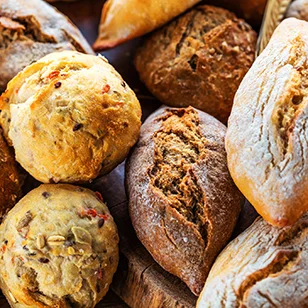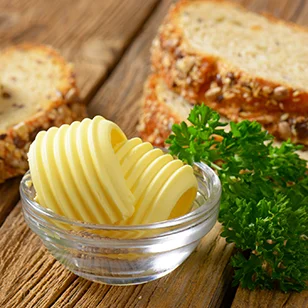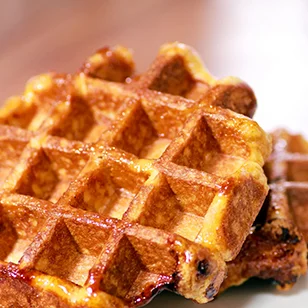Applications
Bakery

Application of lecithin plays a crucial role in bakery, for it improves the quality of dough, ensures even mixing, and enhances the baking process in general. Improved fat dispersion results in total reduction of amounts of fat needed, thus adding light and uniform pore structure of the dough. This, in turn, extends shelf life of breads, cookies, cakes, and other baked goods, keeping them moist and tender.
Moreover, stabilizing and emulsifying properties of lecithin are essential in deep-frozen doughs production. These components inhibit the growth of ice crystals,consequently preventing cracking and drying of frozen products.
Bread

Not many things can compare to a freshly baked bread with a perfect crust and that aroma from childhood. You will need the help of lecithin, because that’s what ensures your baked products longer shelf-life and texture, and that’s what will simplify the handling process of making the dough. In the old times, eggs were used in massive proportions in order to lecithinate the dough. With the amount of bread being consumed today, it is lucky we have lecithin from natural plant origin which can be used for the same purpose.
So, why do we need lecithin and how does it work? Lecithin enhances baking properties, improves the effect of other ingredients, and prolongs the shelf life of baked products while reducing the amount of fat required in a recipe. Lecithin consists of both hydrophilic and lipophilic molecular parts. Mixed with gluten and other dough components, lecithin im¬proves the elasticity of the gluten, and increases gas confinement in the dough. As these transformations take place, processability of the dough is improved leading to a reduced dough manipulation time requirement and real savings in energy. Due to its hydrophilic nature, lecithin offers improved water retention in the dough structure, as it ensures the hydration of proteins. All of these efforts increase loaf volume from the same amount of dough, for fresh out-of-the-oven taste, uniform-pored bread with a crisp crust, and more fine texture. The bread will have a wonderful crust and a soft and delicate texture inside, along with prolonged shelf life.
Summarized benefits
● Increases volume
● Prolongs shelf life
● Improves fat distribution
● Reduces fat and egg
● Secures fermentation stability
● Ensures a homogenous pore structure
● Emulsifying for fat-water systems
Pastry, Biscuits, Cakes, Sponge Cakes, Cookies, Burger Bread, Muffins, Swiss Rolls, Crackers, Sliced Bread

Bakery products listed above, whether produced from ingredients or from a bakery mix have a lot in common - the production process must be easy, fast, and cost effective. Lecithin in the recipe will assure less stickiness during the batter preparation, homogenous distribution of other ingredients, increased machinability, improvement of the flowing properties during the baking process, and even color. In gluten rich dough, lecithin will act as a lubricating agent allowing improved elasticity of the dough and less shrinkage during rolling out. In bakery products with gelatinized starch lecithin is able to form complex bonds with amylose as it is great in water-oil-sugar mixes, ensuring prolonged freshness by slowing down retrogradation.
In recipes with higher fat content, lecithin improves shortening dispersion uniformly through the batter, which allows reduction of the fat content, better label, and cost savings. In cakes, cookies, muffins, and crackers, lecithin ensures homogenous dispersion of fats and constructs a coating around the particles of starch and protein in the dough, preserving them from sticking to each other.
Frozen Doughs

Deep-freezing of the doughs puts an enormous stress on the particles of all ingredients used as the water is transformed into ice crystals. Lecithin is perfect for this application as it balances the water crystal formation in the dough and assures that uniform smaller size ice crystals form during freezing. If the size of the ice crystal is not controlled, those crystals break gluten structure, and damage the yeast particles during the freezing and the thawing process. Damaged gluten structure can bring moisture migration out of the batter, leading to dryness of the final baked product during reheating and baking. Size of the water molecules after thawing also has an important role if the dough is then placed into microwave ovens, as is more and more the case with end consumer frozen dough products.
De-oiled Powdered Lecithin in Frozen Doughs
As the consumption of frozen dough products is growing increasingly popular, more and more manufacturers ask themselves which is the right lecithin for my production. Lecital powdered de-oiled soy and sunflower lecithin are ideal for the use in this application. Compared to liquid lecithin, de-oiled powdered lecithin is easy to handle and it can easily combine with the other dry ingredients. It will stabilize the batter and enhance rheological properties and readily disperse into the dough system. It has also been noticed that Lecital de-oiled powdered lecithin improves fermentation stability. The powdered lecithin is a more concentrated mixture of phospholipids without the oil, enabling a more intense functionality in the dough systems.
Wafles & Wafers

Since lecithin is commonly recognized as a great natural emulsifier, it’s molecules constitute both hydrophilic and lipophilic parts. But this is only one important role which lecithin takes on in a diverse range of waffle products such as ice cream wafers and cones, soft waffles, sugar waffles. Lecithin enhances the mixability between the different waffle ingredients easily building bridges between the fats, water dispersions and the dry ingredients. This leads to a better dough blend and ease of mechanical handling, as well as better formation of the end waffle product in the irons. The second important advantage of lecithin is in the functionality as a release agent which is even more vital for waffle and wafer products. Lecithin assures that your product comes right off the irons, platters, and conveyors, by reducing stickiness to surfaces. The use of lecithin also extends the cleaning intervals of the baking platters or conveyors and prevents waffle breakage.
Lecital lecithin in waffles and wafers can be applied in 2 forms, depending on the convenience of use:
LECITAL S AND LECITAL SF are great quality fluid lecithin from Soy and SunFlower origins respectively. They are both easily soluble in the oil/fat phase of the waffles and wafers and should be mixed in at the shortening or margarine fat phase. LECITAL S AND LECITAL SF are also crucial as a component of release agents for molds and irons.
POWDER LECITAL S and POWDER LECITAL SF are concentrated native de-oiled lecithin in powder form, naturally mixable with the dry ingredients for making the waffle batter. The functionality of the lecithin can be optimized by pre-dispersing them into the water- phase of the waffle/wafer dough. The performance of the active powdered lecithin components is enhanced in water.





















